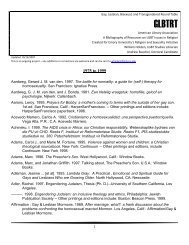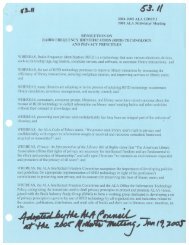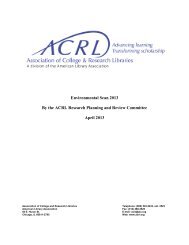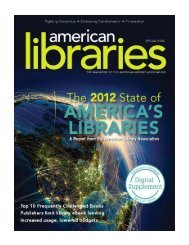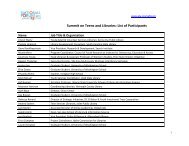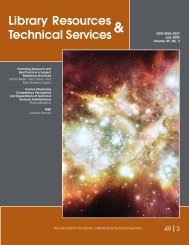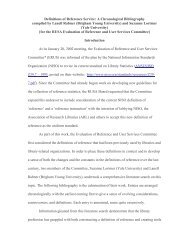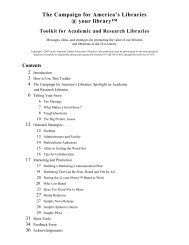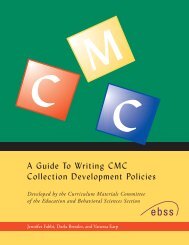Toolkit for School Library Media Programs - American Library ...
Toolkit for School Library Media Programs - American Library ...
Toolkit for School Library Media Programs - American Library ...
Create successful ePaper yourself
Turn your PDF publications into a flip-book with our unique Google optimized e-Paper software.
Collaboration<br />
Collaboration is a key strategy <strong>for</strong> making in<strong>for</strong>mation<br />
power a reality and <strong>for</strong> increasing the visibility of the<br />
school library media program. It can take many <strong>for</strong>ms . . .<br />
everything from fashion shows to oral history projects. In<br />
addition to teachers, it can involve other librarians,<br />
parents, community businesses and service groups—<br />
anyone who wants to help students succeed.<br />
Three good examples from Pennsylvania:<br />
● Eight public and 10 school libraries held a fashion<br />
show during Teen Read Week with middle and high<br />
school students modeling the latest fashions—and<br />
their favorite books. <strong>School</strong> librarians helped select<br />
models to represent their school. Local television<br />
and radio personalities emceed. A local mall<br />
provided free space and retailers provided fashions,<br />
hair styling and make up. The Blair County <strong>Library</strong><br />
System provided $400 to cover pizza, ALA Celebrity<br />
categories you feel are useful.<br />
Internal audiences include:<br />
Staff—full- and part-time<br />
Student assistants<br />
Volunteers<br />
Friends of the library<br />
Other?<br />
External audiences include:<br />
Teachers<br />
Administrators<br />
Students<br />
Parents<br />
Board of education members<br />
Funders: Donors/Legislators/Taxpayers<br />
Prospective partners<br />
<strong>Media</strong><br />
Other?<br />
Key message(s): What is the most important<br />
message you wish to deliver?<br />
Use your key message as often and as consistently as<br />
possible <strong>for</strong> maximum impact, e.g.:<br />
Every student succeeds @ your library.<br />
Strategies: How will you deliver the message?<br />
16<br />
Read Posters, Teen Read bookmarks and other<br />
giveaways. (Contact: Vivian Van Dyke, vvandyke@<br />
altoonasd.com)<br />
● Inspired by the <strong>Library</strong> of Congress’ <strong>American</strong><br />
Memory Project, 4th and 5th graders prepared<br />
PowerPoint presentations about family members’<br />
memories such as immigration to the U.S., a family<br />
heirloom, historic event or childhood recollection.<br />
The project involves library, technology and<br />
teaching staff from the Wickersham Elementary<br />
<strong>School</strong>, Lancaster Country Day <strong>School</strong>, Lancaster<br />
County <strong>Library</strong>, <strong>Library</strong> System of Lancaster County<br />
and Millersville University; also the Lancaster Literacy<br />
Guild. (Contact: Linda Carvell, carvelll@e-lcds.org)<br />
● Students and seniors connect in a project sponsored<br />
by the media center of the Western Wayne Middle<br />
<strong>School</strong> and the Salem Public <strong>Library</strong>. Students send<br />
email to the public library’s senior citizens group<br />
telling about their favorite objects and hobbies.<br />
Seniors respond by sharing the things they<br />
Identify publicity and outreach activities aimed at<br />
your target audiences. You will need to identify a<br />
timetable and person responsible <strong>for</strong> each activity.<br />
Strategies <strong>for</strong> delivering the message include:<br />
Banners/Posters/Displays<br />
Handouts/Giveaways, e.g., bookmarks, mugs<br />
<strong>Media</strong>: <strong>School</strong> and community newspapers, radio and TV<br />
Print materials: annual report, newsletter, flyers, tent cards, etc.<br />
Web sites<br />
E-mail lists<br />
Presentations to groups<br />
Collaboration with other departments/organizations<br />
Word of mouth<br />
Evaluation measures: How will you know what<br />
worked and what didn’t?<br />
Your objectives should provide a clear means of<br />
evaluation. Frequently used measures include:<br />
circulation, Web site visits, attendance at programs,<br />
number of media stories placed/speeches given,<br />
follow-up surveys/interviews, word-of-mouth<br />
feedback, letters of appreciation, honors received.<br />
Review each strategy and why it did or didn’t work.<br />
Use what you learned in making next year’s<br />
communication plan.



